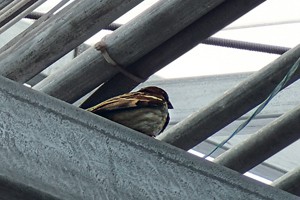
This male sparrow in the ceiling structure is safe from the elements and predators. Photo: Kate McGovern
Jeff’s assessment protocol involves evaluating the account from top to bottom, inside and out. In some instances, a roof evaluation is also needed.
To assist in the initial assessment, Jeff consults a list of questions he asks every account:
1. Why are birds attracted to the building?
2. Are birds a problem inside, outside or both?
3. Are there conducive conditions that can be altered to relocate the birds?
4. If the birds are gaining access, how are they doing it?
5. Are the access points structural, such as holes in walls?
6. Are the access points the result of human activity, such as doors left open?
7. If the birds are inside, what are their flight patterns, hangouts and harborages? In some cases, inside birds might be using the building as harborage and moving in and out at will.
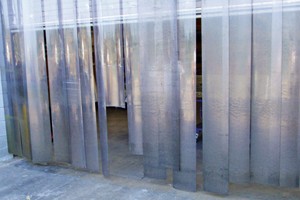
Broken and missing pieces of a plastic strip door allow access to birds, insects and rodents. Photo: Kate McGovern
Jeff cases the outside, noting bird activity on the exterior of the building, the chain link fencing, the signage and the exterior plantings (particularly the trees on the parking island). Previously installed netting remediation still appears to be working well on the signage. There are also visible employee processes to keep the parking lot clear of trash and debris during store hours. Birds roosting in parking lot trees had been a challenge previously, when there was no effective solution. Years later, the trees have grown — along with the number of sparrows, grackles and crows roosting in them. Jeff makes a note to tell the general manager about a shock mesh wire that can be installed in trees to discourage roosting birds.
The noise is deafening in the store’s garden center area, which is surrounded by chain link fencing.
Spring is in the air on this early-April day, and male sparrows fill the openings in the fencing, desperately singing to catch the attention of the females. Jeff takes a few moments to observe this avian paradise. There’s a high roof supported by large metal trusses. Each point of the truss is crammed with sparrow nests, which are typically made of found trash and plant materials, but high up in the trusses, they’re safe from interference and predators. If they need anything,
it’s just beyond a doorway.
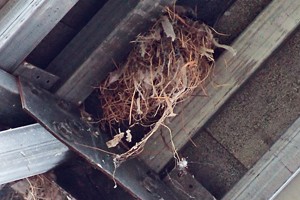
Sparrow nests, featuring careless assortments of trash and plant materials, are typically messy. Photo: Kate McGovern
Jeff strikes up casual conversations with employees and managers to glean valuable information about the sparrows’ flight patterns inside the building. He also learns about a male mockingbird that’s been terrorizing customers in another section of the store.
Inside, the link between the sparrows inside and outside is obvious. Dock-area doors propped open by employees, gaps around the dock doors, and trucks being unloaded — each factor has created easy entry points for birds. Jeff makes notes of what to discuss with the general manager. He suggests replacing and extending bumper pads in the truck bay, and reminding employees to not prop the doors open.
Another concern is how a motion-detecting electronic eye operates the two doors between the garden and the retail areas. Birdseed and feeders are available for sale just inside the doors, which the sparrows have learned to trigger on their own. Not surprisingly, this is where most of the droppings and damage are.
During our visit, five birds fly freely in the store. Because the facility is part of a national chain, it is bound to the planograms issued by the company for floor displays. It’s also bound by company policy of non-lethal capture, so Jeff suggests the general manager schedule a mist-netting session with the pest management company within the next week. Jeff also suggests the possibility of leaving behind about six trapdoor traps to address the pest pressure.
An employee takes us to the other side of the store, where the mockingbird is dive-bombing customers. The problem is immediately clear: There’s a dock door through which equipment goes in and out, and some of the plastic strips filling the opening to block insects (and birds and rodents) are broken or missing. The mockingbird entered the store through one of the gaps, and worked to expand his territory. The easy fix to this problem is to replace the broken and damaged strips, which also helps reduce the increasing flying-insect population inside the store.
Before leaving, Jeff was able to speak with the general manager about his recommendations. The GM was appreciative of the suggestions, and agreed to contact the pest management company to schedule a mist net service within the week. Jeff would help with the mist netting and trap placement.All things considered, it was a good day for renewed partnerships and progress.
You can reach Kate and Jeff McGovern at jefferymcgovern@mindspring.com.
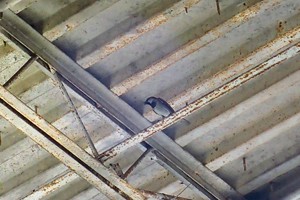
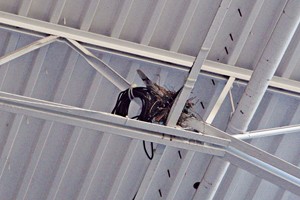
Leave A Comment